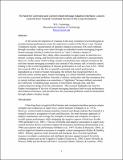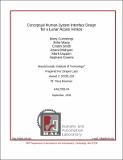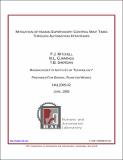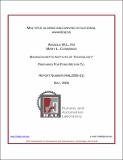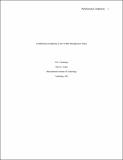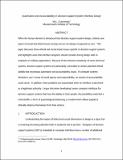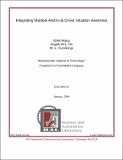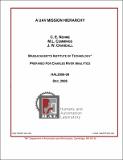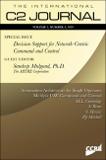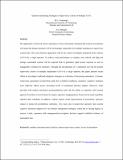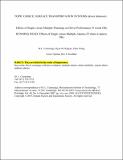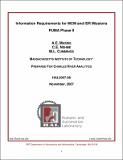Browsing HAL Reports by Issue Date
Now showing items 1-20 of 69
-
Human Supervisory Control Issues in Network Centric Warfare
(MIT Humans and Automation Laboratory, 2004)Network centric warfare (NCW) is a concept of operations that seeks to increase combat power by linking battlespace entities to effectively leverage information superiority. A network centric force must be supported by ... -
The Need for Command and Control Instant Message Adaptive Interfaces: Lessons Learned from Tactical Tomahawk Human-in-the-Loop Simulations
(CyberPsychology and Behavior, 2004)In the recent development of a human-in-the-loop simulation test bed designed to examine human performance issues for supervisory control of the Navy’s new Tactical Tomahawk missile, measurements of operator situation ... -
Conceptual Human-System Interface Design for a Lunar Access Vehicle
(MIT Humans and Automation Laboratory, 2005)In support of the vision for humans to establish a large scale, economically viable, permanent human settlement on the Moon within the next 25 years (Space Frontier Foundation, 2005), the next generation lunar landing ... -
Mitigation of Human Supervisory Control Wait Times through Automation Strategies
(MIT Humans and Automation Laboratory, 2005)The application of network centric operations principles to human supervisory control (HSC) domains means that humans are increasingly being asked to manage multiple simultaneous HSC processes. However, increases in the ... -
Multiple Alarms and Driving Situational Awareness
(MIT Humans and Automation Laboratory, 2005)There is increasing interest in actively mitigating safety in vehicles beyond that of improving crash worthiness. According to the National Highway Transportation Safety Administration (NHTSA), there are more than 40,000 ... -
Partitioning Complexity in Air Traffic Management Task
(International Journal of Aviation Psychology, 2006)Cognitive complexity is a term that appears frequently in air traffic control (ATC) research literature, yet there is little principled investigation of the potential sources of cognitive complexity. Three distinctly ... -
Decision Support Design for Workload Mitigation in Human Supervisory Control of Multiple Unmanned Aerial Vehicles
(MIT Humans and Automation Laboratory, 2006)As UAVs become increasingly autonomous, the multiple personnel currently required to operate a single UAV may eventually be superseded by a single operator concurrently managing multiple UAVs. Instead of lower-level tasks ... -
Integrating Automobile Multiple Intelligent Warning Systems : Performance and Policy Implications
(MIT Humans and Automation Laboratory, 2006)Intelligent driver warning systems can be found in many high-end vehicles on the road today, which will likely rapidly increase as they become standard equipment. However, introducing multiple warning systems into vehicles ... -
An Analysis of Information Complexity in Air Traffic Control Human Machine Interaction
(HAL Humans and Automation Laboratory, 2006)This thesis proposes, develops and validates a methodology to quantify the complexity of air traffic control (ATC) human-machine interaction (HMI). Within this context, complexity is defined as the minimum amount of ... -
Audio Decision Support for Supervisory Control of Unmanned Vehicles : Literature Review
(MIT Humans and Automation Laboratory, 2006)Purpose of this literature review: To survey scholarly articles, books and other sources (dissertations, conference proceedings) relevant to the use of the audio supervisory control of unmanned vehicles. -
Cognitive Task Analysis for the LCS Operator
(MIT Humans and Automation Laboratory, 2006)The following Tables and Figures detail the cognitive task analysis (CTA) performed to determine the information requirements needed to support a single operator located aboard the futuristic Littoral Combat Ship (LCS). ... -
Automation and Accountability in Decision Support System Interface Design
(Journal of Technology Studies, 2006)When the human element is introduced into decision support system design, entirely new layers of social and ethical issues emerge but are not always recognized as such. This paper discusses those ethical and social impact ... -
Integrating Multiple Alarms & Driver Situation Awareness
(MIT Humans and Automation Laboratory, 2006)This study addresses this gap in CAS and intelligent alarm research by examining whether or not a single master alarm warning versus multiple warnings for the different collision warning systems conveys adequate information ... -
A UAV Mission Hierarchy
(MIT Humans and Automation Laboratory, 2006)In the following sections, each of the primary missions are decomposed into mission planning, management, and replanning segments in order to identify what the primary functions a human operator will need to perform. The ... -
Automation Architecture for Single Operator, Multiple UAV Command and Control,
(The International Command and Control Journal, 2007)In light of the Office of the Secretary Defense’s Roadmap for unmanned aircraft systems (UASs), there is a critical need for research examining human interaction with heterogeneous unmanned vehicles. The OSD Roadmap clearly ... -
Identifying Predictive Metrics for Supervisory Control of Multiple Robots
(IEEE Transactions on Robotics, 2007)In recent years, much research has focused on making possible single operator control of multiple robots. In these high workload situations, many questions arise including how many robots should be in the team, which ... -
Operator Scheduling Strategies in Supervisory Control of Multiple UAVs
(Aerospace Science and Technology, 2007)The application of network centric operations to time-constrained command and control environments will mean that human operators will be increasingly responsible for multiple simultaneous supervisory control tasks. One ... -
Effects of Single versus Multiple Warnings on Driver Performance
(2007)Objective: To explore how a single master alarm system affects drivers’ responses when compared to multiple, distinct warnings. Background: Advanced driver warning systems are intended to improve safety, yet inappropriate ... -
Information Requirements for MCM and ISR Missions : PUMA Phase II
(MIT Humans and Automation Laboratory, 2007)This document contains display requirements for Littoral Combat Ship (LCS) control station displays to be used by unmanned vehicle units in support of heterogeneous unmanned vehicle missions (such as Special Operations ... -
Assessing the Impact of Auditory Peripheral Displays for UAV Operators
(MIT Humans and Automation Laboratory, 2007)A future implementation of unmanned aerial vehicle (UAV) operations is having a single operator control multiple UAVs. The research presented here explores possible avenues of enhancing audio cues of UAV interfaces ...


